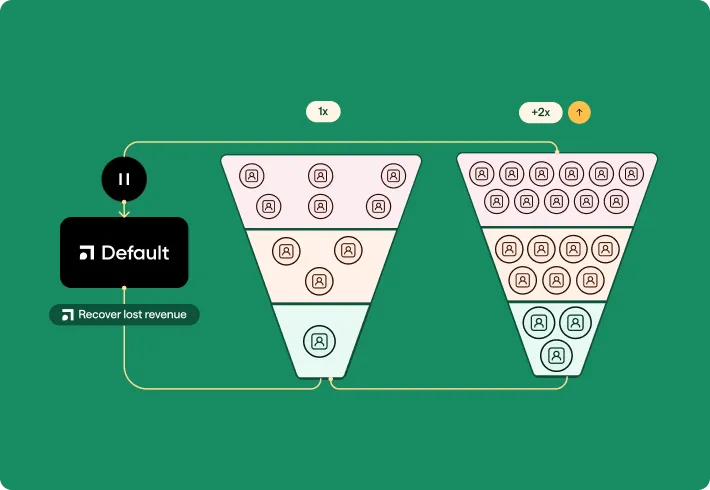Try Default

See how revenue teams automate revenue operations with Default.

Key Takeaways
As your website attracts more visitors and converts more leads, don’t make the same mistake as many fast growing companies—handling inbound sales manually. While this may work for some time, eventually it’ll lead to lead dropoff, missed opportunities, and lost revenue.
With inbound sales automation (like Default), you can tighten up your processes, equip sales reps with all the information they need, and accelerate your revenue growth.
How does inbound sales automation help you execute on your GTM strategy?
Implementing a GTM motion has a million steps, and often inbound sales automation isn’t top of mind. Most of the time, it’s lumped in with the vague “technology” category, making it little more than an afterthought.
This is a mistake. Although, yes, you need to have your ideal customer profiles, positioning, and messaging in place, a GTM strategy doesn’t work unless you can execute on it effectively.
Here are three ways inbound sales automation impacts your GTM motion.
Accelerate your inbound pipeline
If effective, your website will drive leads and conversions. But what happens to those conversions once they’re in your CRM? In most cases, pipeline slows down with issues stemming from:
- Pipeline imbalance, where leads bottleneck in one stage and are absent in another
- Pipeline leakage, where leads just abandon the sale process
- Pipeline stagnation, where leads don’t abandon the process, but aren’t moving forward
None of these problems are strategic in nature; they come down to your technical ability to monitor and make adjustments to your sales practice. Yet they all keep you from executing your strategy.

The solution: Adopt a unified inbound sales automation platform that creates, routes, and closes your leads; provides a unified view of a lead’s journey, information, and activity; and automates qualification and follow up via workflows.
Learn more about how Default accelerates your inbound pipeline here.
Simplify revenue operations
You can’t effectively execute a GTM strategy if your revenue operations are overly complex and confusing. If your sales leaders and reps are spending their time porting data from your lead capture platform to your CRM, that’s time not spent selling.
Plus, the more complex your revenue operations , the more confusing it is for everyone on your team. Which means that you have less transparency into the process; which, in today’s remote and hybrid world, can be a business-killer.

The solution: Consolidate lead management, CRM automation, and routing into a unified platform. This will shorten your sales cycle, and give you greater visibility into your marketing and sales performance.
Learn more about how Default simplifies revenue operations here.
Recover lost revenue
According to SalesLion, 60% of pipeline is lost due to “no decision,” not a competitor. Automating inbound sales can help you keep your company top-of-mind with regular reminders, route leads to the best person to answer their questions, and get meetings on the calendar without reps spending hours out of their week following-up.
What’s more, when all your sales processes are automated within a single platform, it’s easier for sales leaders to see where deals are falling through, and update your systems to close off that leakage.

The solution: Find a platform that automates leads that abandon the scheduling process to avoid drop-off.
Learn more about how Default helps you recover lost revenue here.
How to automate inbound sales within Default
Now that we’ve looked at the benefits of automating inbound sales, let’s dive into the solution; namely, Default. Here’s how Default achieves those three objectives on a practical, tactical level.
Match new contacts to existing accounts
Managing B2B accounts is complex. There are individuals within the organization who, for one reason or another, engage with your website and other content. If your messaging is strategically aligned with your ICP, some of them will inevitably convert.
If different people from the same company convert on your website, you need to offer them a consistent experience—speaking with the same rep as the previous contact, for example. Otherwise, you risk appearing unprofessional and disorganized—which undercuts your ability to close.

Automate data enrichment and exchange
There’s precious little you can tell about a lead with the information you capture in five form fields (especially if two of those fields are First Name, Last Name, and Email). The problem is that your inbound sales automation platforms are only as good as the data inside them. And bad data leads to bad sales motions.
Rather than spend endless hours manually scraping, cleaning, and syncing data between your marketing tools, sales automation platform, and CRM, Default enables automated data enrichment and syncing across all your platforms.
By combining captured data, third-party enriched data, and pre-existing data inside your CRM, Default provides a 360-degree view of your prospects. This enables more sophisticated automations and personalized experiences, increasing your chances of engaging and closing the deal.

Route leads to the right contact right internal contact
The best person to handle the first call with a lead is the one most likely to qualify or close it. Unfortunately, many sales teams rout inbound leads using “round robin.”The problem is that the rep assigned the lead at random may not be the best person to handle it:
- Lack of knowledge and experience in the specific industry
- Not qualified to handle larger accounts (i.e. no experience with enterprise sales)
- Low-performing reps keep getting assigned inbound leads
- Obviously unqualified leads get sent to sales, wasting their time
Many sales automation platforms work around this problem by assigning routing rules that send specific leads to the most qualified sales rep. This is good as a general principle, but many accounts are nuanced and there are always outliers. Most technology can’t handle this level of complexity.
Default, on the other hand, is set up to handle not only normal routing rules, but also outliers and exceptions. You can rest assured that if a lead comes through your website, it’ll make it to the right person.

Continually engage the lead post-conversion
Handling the lead post-conversion is only the first step. Plenty of sales leads drop off either before or after that first meeting, which means that sales reps have to be proactive in keeping them engaged. Doing this manually and at scale, however, can be challenging, to put it lightly.
This can take a variety of forms, including:
Real-time qualification. Qualify, route, and segment inbound any CRM objects from one platform.
.svg)
Automated email follow-ups. Automate lead drop-off and put leads into email sequences to recover lost revenue.
.svg)
Instant scheduling. Best-in-class scheduling that books meetings, routes leads, and updates your CRM in milliseconds. Grow your pipeline and shorten your sales cycle with insanely fast personal or round-robin scheduling links.

Free your sales reps from menial tasks
At the end of the day, your sales reps should spend most of their time doing what they do best: selling. If they’re too busy scheduling, importing data, and figuring out who’s going to handle which lead, then that’s time they aren’t spending winning new business.
With Default, you can streamline your sales operations with a single platform that manages routing, scheduling, data enrichment, and reporting in one central location. Accelerate your inbound pipeline, recover lost revenue, and empower your sales team to close more business.
Ready to start automating your inbound sales processes today? Tired of duct-taping together platforms? Get a Default demo so you can transform and accelerate your pipeline.
Conclusion

Building Default to help the next 10 million B2B companies grow from zero to IPO better, faster, and cheaper.
Accelerate your growth with Default.
Revamp inbound with easier routing, actionable intent, and faster scheduling














.png)

























